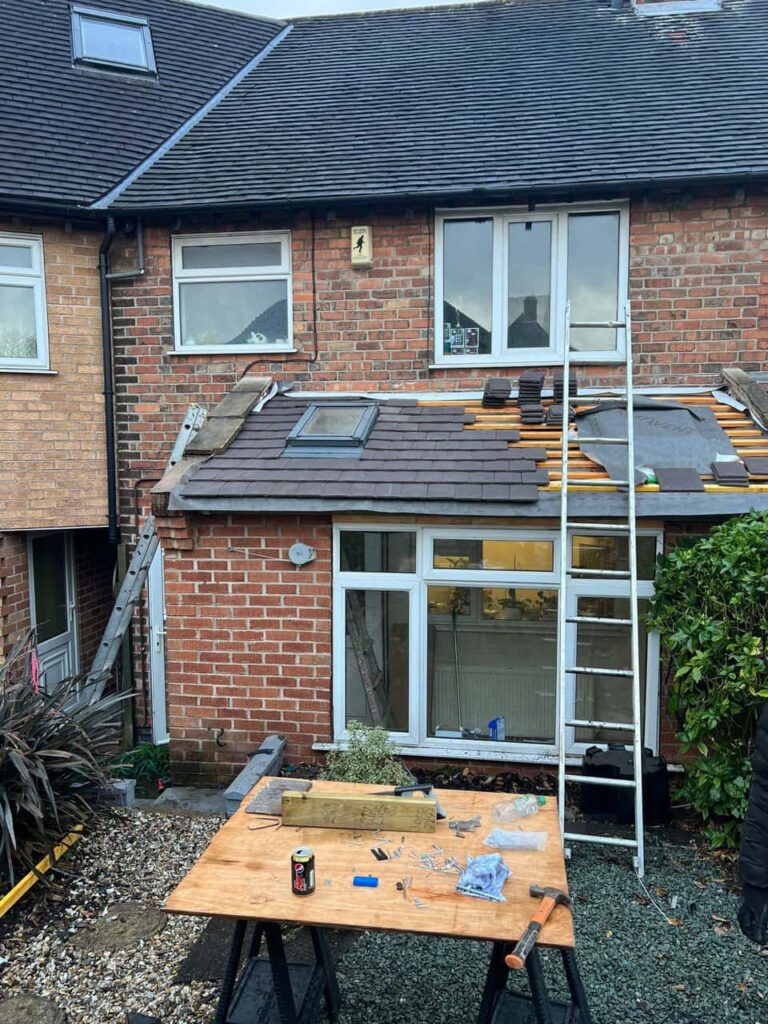Leadwork is a crucial part of your roof’s structure. It helps prevent water from infiltrating vulnerable areas such as valleys, chimneys, and roof junctions. However, over time, lead can deteriorate, leading to significant roofing problems. If you live in Wingerworth, Nottinghamshire, and are noticing signs of damage, it’s essential to act quickly before further harm is caused to your property. In this blog post, we will explain the key signs that your roof leadwork has failed and why professional repairs are necessary to restore your roof’s integrity.
1. Visible Cracks or Holes in the Leadwork
One of the most apparent signs of leadwork failure is visible cracks or holes in the lead flashing or sheets. Lead naturally expands and contracts with changes in temperature, and over time, this can cause it to crack or wear thin.
- Cause: Weather conditions such as frost, intense heat, or heavy rainfall can contribute to the degradation of lead. Constant expansion and contraction eventually lead to cracks forming.
- Effect: Cracks and holes allow water to penetrate, which can cause leaks inside your home, damaging ceilings, walls, and insulation.
- Solution: If you spot any visible cracks or holes in your leadwork, it’s crucial to have it inspected and repaired by a professional roofer to prevent further water damage.
2. Discolouration or Staining Around the Leadwork
If you notice dark stains or discolouration around your lead flashing or joints, it could be an indication that water has been seeping through the damaged areas of your leadwork.
- Cause: Water leaking through damaged leadwork can leave behind stains, often showing up on your walls or ceiling. This is especially noticeable in areas like chimneys, dormer windows, and valleys.
- Effect: Persistent water leakage can cause more severe issues like dampness, mould, and mildew in the interior of your home, potentially leading to health risks.
- Solution: Stains around leadwork should be checked immediately, as they often indicate a failure in the waterproofing, requiring prompt repairs or lead replacement.
3. Leadwork Appearing Buckled or Lifted
Over time, leadwork can become warped or lifted from its original position. This could occur due to either improper installation or because the lead has reached the end of its lifespan.
- Cause: Lead can distort if it has been exposed to extreme temperatures, or if it was poorly installed. Physical damage, such as a heavy object falling on the roof, can also cause lead flashing to become buckled or lifted.
- Effect: When lead is buckled or lifted, it no longer forms a tight seal, allowing water to enter the roof and potentially cause internal damage.
- Solution: If you notice any buckled or lifted leadwork, professional roofers should assess the situation and perform necessary repairs or replacements to restore the integrity of your roof.
4. Rusting or Corrosion Around Lead Flashing
Lead is naturally resistant to rust, but if the lead is combined with other materials that are not as corrosion-resistant, rust or corrosion can occur.
- Cause: Rust and corrosion are usually the result of a reaction between the lead flashing and other materials, such as iron or steel. This can cause the leadwork to break down, especially where water has been trapped.
- Effect: Rust or corrosion weakens the leadwork, making it more vulnerable to leaks and further damage.
- Solution: If you observe rust or corrosion, it’s a sign that the leadwork has failed and needs to be replaced or repaired to prevent further deterioration.
5. Increased Energy Bills or Dampness in the Home
Water leaking from damaged leadwork may not always be immediately visible inside the house. However, increased dampness in the home or rising energy bills can be an indirect sign that your leadwork is no longer functioning properly.
- Cause: Leaks caused by failed leadwork can result in moisture building up within the walls and ceiling of your home, leading to a damp environment that makes it harder to heat the home effectively.
- Effect: Dampness can cause higher energy costs, as heating systems have to work harder to maintain the desired temperature, while also encouraging the growth of mould, which can affect the health of residents.
- Solution: If you are experiencing higher energy bills or noticing signs of dampness, it’s important to have your leadwork inspected to rule out water leakage.
6. Presence of Cracked or Missing Mortar Around Lead Flashing
Lead flashing often works in tandem with mortar to form a watertight seal. If the mortar around your leadwork is cracked or missing, it can significantly reduce the effectiveness of the lead flashing.
- Cause: The mortar around lead flashing can crack or degrade due to exposure to the elements or as a result of poor installation practices.
- Effect: If the mortar fails, water can seep through the gaps, compromising the waterproofing and causing damage to the roof or interior of the home.
- Solution: Mortar damage should be addressed immediately by a professional roofer, who will re-point the lead flashing or replace the mortar as necessary to ensure the roof remains watertight.
Conclusion
Leadwork is a crucial element of your roof’s waterproofing system, and when it fails, it can lead to significant damage to your home. If you notice any of the signs mentioned above, it’s essential to act quickly to prevent further issues. Whether it’s cracks, corrosion, or the failure of flashing, prompt repairs or replacements of your leadwork will save you from more costly repairs in the future.
At Wingerworth Roofing Repairs, we specialise in leadwork repairs and replacements. If you’re in Wingerworth, Nottinghamshire, or surrounding areas, our team can help you address any roofing issues with professional care and expertise. Don’t wait for small problems to turn into major issues—contact us today to schedule a roof inspection and keep your home safe and dry.
Call us on: 01246 956 395
Click here to find out more about Wingerworth Roofing Repairs
Click here to complete our contact form and see how we can help with your Roofing needs.

